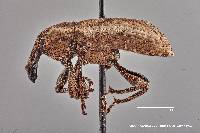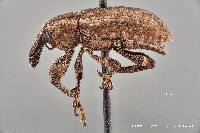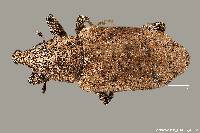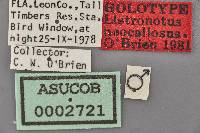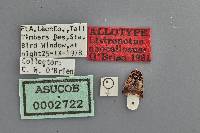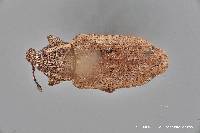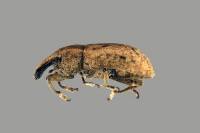Go to Encyclopedia of Life...
Listronotus neocallosus OBrien, new species Holotype male. - Elongate oblong. Body black, antennae and tarsi dark reddish brown to black. Densely clothed with contiguous and/or imbricate, recumbent, oval, brown, golden brown, and whitish brown scales, narrower and more elongate on median area of pronotum; and with sparse, very short, inconspicuous, clavate, subrecumbent, scalelike seta. Rostrum scarcely longer than prothorax, broad and stout, nearly straight, apex very weakly depressed; tricarinate, lateral carinae moderately developed; moderately densely clothed with small, round, oval and elongate, laterally directed, recumbent scales; punctures dense, large, many substriate. Head weakly convex, densely punctate, clothed rather densely with elongate, medially directed, recumbent, setalike scales; frons laterally convex, medially flattened, with elongate, median impression with very deep, large fovea at base of rostral carina; with only few round scales around fovea, remainder with scales as on head. Antennae moderately slender; funicular segment 2 ca. 1/3 longer than 1; segment 3 longer than 4; segments 4, 5 and 6 subequal in length, becoming broad apically; segment 7 broadly transverse, slightly longer than 6; club broadly oval, not acuminate, subequal to segments 4 through 7 together. Prothorax ca. 1/7 wider than long, sides nearly straight, weakly expanding to suddenly constricted apex; ocular lobes strongly developed; apical dorsal margin sinuate; disc densely clothed with round, oval, and elongate, recumbent, contiguous scales, densest on lateral 1/4 of disc and pleural areas; median 1/2 with elongate scales; most scales brown, with distinct, broad, pale, whitish brown, lateral, longitudinal, oblique stripe; often with narrow, pale, median stripe; disc and pleuron with moderately dense, large, distinct, shining punctures each with short, suberect, subclavate, scalelike seta. Scutellum small, oval, somewhat U-shaped, rather densely clothed with elongate, golden brown to white, recumbent scales. Elytra moderately strongly arcuate at base; anterior margin reflexed from intervals 3 through 5; humeri angulate; sides straight behind humeri, very weakly narrowing to declivity, there sharply narrowed to slightly emarginate apex; striae distinct though narrow, with widely separated, small, deep, elongate punctures; intervals uneven, flat and convex, in part transversely wrinkled, densely clothed with broadly oval to round, contiguous and imbricate, recumbent, brown to whitish scales; with 1 to 3 uneven rows of moderately dense, indistinct, short, subrecumbent, clavate, scalelike setae; posterior calli very weakly developed, often clothed in part with spot of black scales; often with broad, post-humeral, pale, whitish marginal stripe. Legs moderately stout; femora clothed with moderately sparse, elongate, recumbent, scalelike setae, and distinct annulus of subapical, round, pale, dense, partially imbricate, recumbent scales; tibiae clothed with mixture of recumbent, round scales and recumbent to suberect, coarse setae; hind tibiae weakly denticulate on inner margin; mucrones long, straight, angulate at base but lacking basal tooth. Venter with plumose scales in median prosternal groove, behind forecoxae, on all coxae and on mesepimeron; sides of metasternum and margins of abdominal sterna with dense, round, recumbent scales; remaining area with moderately dense, recumbent to erect, coarse to fine setae; abdominal sternum 1 broadly, moderately deeply, medially impressed; sternum 2 broadly weakly impressed; sternum 5 weakly convex, scarcely medially impressed at apex, with apex truncate. Length, pronotum and elytron: 8.3 mm. Allotype female. - Elytra with apex conjointly rounded, or scarcely emarginate. Venter with abdominal sternum 1 with anterior median process transversely concave; medially, transversely arched, flat to convex; posteriorly, narrowly shallowly concave; sternum 2 anteriorly, narrowly, weakly concave to flat, posterior 2/3 flat; sternum 5 with 2 large, lateral and 1 small, narrow, median, apical impressions. Length, pronotum and elytron: 9.45 mm. Etymological Note. - The epithet neocallosus is given in reference to the great similarity of this species and L. callosus. Remarks and Comparative Notes. - The 235 specimens on hand range in size from 8.3 to 11.1 mm. This rather large and cryptic species appears most similar to callosus, but the latter has strongly developed posterior elytral calli and has all antennal funicular segments elongate. Also ingens has a similar appearance but it too has all antennal funicular segments elongate and lacks transverse elytral wrinkles. A species often collected at the same localities, palustris, differs in its much darker base color, its narrower form with the elytra prolonged at the apices in the female, and dense covering of large pale round scales on the margins of the abdominal sterna. In all cases the distinctive genitalia will distinguish this deceptive species. The host of this species is Sagittaria engelmanniana J.G. Smith. Specimens were collected in the field feeding on leaves of this host, and specimens in the laboratory laid eggs on and in leaf petioles and larvae developed in galleries within the leaf petiole and root collar of this species. Several of these larvae pupated and one reached the adult stage. Adults were taken in the field feeding on 2 other species of Sagittaria, graminea Michaux and stagnorum Small. The latter 2 species are small plants, probably too small for complete development of the larvae of this species. Range. - Known only from northern Florida.




